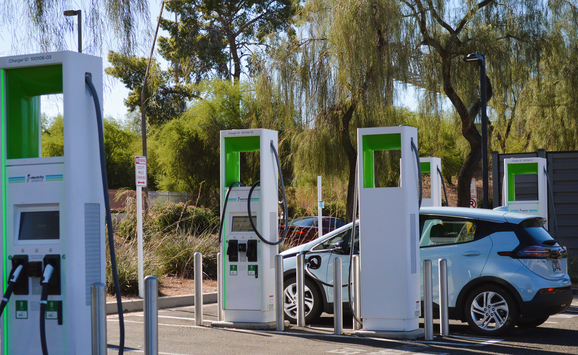A new analysis from Resources for the Future shows that likely upcoming electric vehicle policy reversals would impose a $33-billion cost overall.
The US Congress and the Trump administration are preparing to revoke Biden-era electric vehicle (EV) policy. To that end, the federal budget, which recently was passed by the House of Representatives and now has moved to the Senate, would eliminate subsidies for buying EVs and producing batteries domestically. Congress or the US Environmental Protection Agency may also reverse federal greenhouse gas emissions and fuel economy standards for passenger vehicles and revoke permission for California to run its Advanced Clean Car program, which would require that all new vehicles be plug-in EVs by 2035. Using the Vehicle Market Model created by Resources for the Future (RFF), we find that, on balance, these EV policy reversals would produce societal costs of about $33 billion in 2030.
Policy Context
Vehicle electrification, a promising solution to decarbonizing the transportation sector, has until now been supported by a group of policies that reduce the cost of making and buying EVs. The Inflation Reduction Act has provided vehicle purchase subsidies for new and used vehicles (both commercial and passenger vehicles) and advanced manufacturing tax credits (which help reduce the cost of making batteries).
Two major sets of regulatory standards have incentivized EV production to date. The first is the federal greenhouse gas emissions standards and Corporate Average Fuel Economy standards that the Environmental Protection Agency and the National Highway Traffic Safety Administration adopted in 2024 for vehicle models sold after 2026. (We’ll refer to these two standards in shorthand as the greenhouse gas standards.) The second is the Clean Air Act waiver, which allows California to set its own emissions standards. California has used this waiver as the basis for the Advanced Clean Cars program, which requires manufacturers in the state to achieve 100 percent plug-in vehicle sales by 2035. (Eleven other states and Washington, DC, have adopted similar mandates under the waiver.)

Recent efforts are changing these policies dramatically. First, the House budget proposal released in May would repeal the vehicle purchase subsidies in the Inflation Reduction Act and make eligibility for the battery subsidies so onerous as to essentially eliminate the subsidies. Furthermore, the National Highway Traffic Safety Administration and the Environmental Protection Agency have indicated that they will reverse the fuel economy and greenhouse gas standards that help incentivize EV sales.
Second, in late May, the House and Senate voted to revoke California’s waiver through the Congressional Review Act. Given the impending reversal of federal support for EVs, now is the time to understand what these policy changes could do. What would happen to EV sales and greenhouse gas emissions? How would households, manufacturers, and the federal budget be affected?
Focusing on the year 2030 as representative of potential near-term effects of the policy changes, we report results from simulations with the RFF Vehicle Market Model under two scenarios: (a) the policy framework as it exists, prior to any proposed executive and legislative changes, and (b) EV policy reversal, which entails removing subsidies from the Inflation Reduction Act, freezing greenhouse gas standards at 2026 levels, and eliminating the Advanced Clean Cars program. Comparing these two scenarios evaluates the effects of likely upcoming policy changes relative to current policies.
Vehicle Sales
The EV policy reversal would increase total new vehicle sales in 2030 by about 800,000 units (about 5 percent) on net (Figure 1), while reducing vehicle prices by about 10 percent. Though the policy reversal would increase total vehicle sales, it would achieve this boost through a substantial shift from EVs to gasoline vehicles. In fact, EV sales would decrease by about 1.7 million units (30 percent), while gasoline vehicle sales would increase by about 2.5 million units (25 percent). These changes seem roughly in line with modeling results by other groups.
Figure 1. Effect of Electric Vehicle Policy Reversal on Vehicle Sales

Societal Impacts
The EV policy reversal would financially benefit manufacturers, as their total profits would increase by about $15 billion (Figure 2). Under weaker regulations, manufacturers would not have to adopt extra fuel-saving technologies or sell additional EVs, thereby raising their profits.
Figure 2. Social, Fiscal, and Public Health Impacts of Reversing Electric Vehicle Policy

Notes: All numbers represent results in 2030 and are represented in 2022$. Consumer well-being includes the private benefits consumers enjoy from purchasing new vehicles, net of post-subsidy purchase price and lifetime vehicle fuel costs. Social impacts of carbon dioxide emissions include the global costs of carbon dioxide and greenhouse gas emissions. Health impacts of local air pollution include premature mortality caused by fine-particulate pollutants. Federal budget savings include the unspent subsidies on vehicle purchases and battery production. Net social impacts is the sum of the other bars.
However, while manufacturer profits would increase, the EV policy reversal would harm consumers and the environment.
Although vehicle prices would be reduced due to these policy reversals, weakening the federal greenhouse gas standards and eliminating the Advanced Clean Car program would increase fuel costs over vehicle lifetimes as consumers would now own fuel-inefficient vehicles. Importantly, these higher fuel costs would outweigh the benefit of lower vehicle prices. In sum, we find that consumer well-being would decline by about $27 billion (Figure 2, second bar). (Consumer well-being includes the private benefits consumers enjoy from purchasing vehicles, net of post-subsidy purchase price and fuel costs.)
The EV policy reversal also obviously would increase greenhouse gas emissions. Including global impacts on climate change (using the social cost of carbon and methane emissions) and the estimated costs of worsened local air quality, we see that the policy reversal would yield about $50 billion of environmental costs over the lifetimes of vehicles sold in 2030.
Finally, these policy reversals would generate federal budget savings of about $30 billion by eliminating subsidies for EV purchases and battery production.
Policy Reversals: Intention vs. Net Effects
If we add up all the benefits and costs, we find that a reversal of EV policy would have the overall effect of imposing about $33 billion in costs on total societal well-being. Though the EV policy reversal would benefit manufacturers and reduce the federal budget deficit, the reversal of federal policy would not benefit society as a whole.
Our analysis shows that the costs to vehicle buyers and costs to the environment far outweigh the benefits this policy reversal could achieve. Recent announcements indicate that EV policies may be weakened even further below the levels considered in this blog post; prior analysis indicates that such changes would cost society even more.
In sum, reversing federal policy support for EVs may ease the federal balance sheet and boost gasoline vehicle production—but these potential benefits would come at a steep cost to not just our wallets, but also our planet.

For more timely insights about developments in environmental and energy policy, browse the If/Then series.







